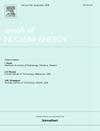Impact of U-10Mo HALEU fuel element tolerances on the Massachusetts Institute of Technology reactor safety and operational performance – Thermal hydraulics
IF 1.9
3区 工程技术
Q1 NUCLEAR SCIENCE & TECHNOLOGY
引用次数: 0
Abstract
The U.S. is coordinating efforts for the conversion of six U.S. High Performance Research Reactors (USHPRR) including one critical facility from highly enriched uranium (HEU) to low-enriched uranium (LEU). In order to continue the mission of these reactors, including the Massachusetts of Institute of Technology Reactor (MITR), and achieve similar performance, high-assay low-enriched uranium (HALEU) with a high-density metallic alloy of uranium with 10 wt% molybdenum (U-10Mo) is being evaluated. The impact of the fabrication specification and tolerances was assessed following the preliminary design of the MITR LEU fuel elements using the U-10Mo monolithic alloy. This research focuses on the analysis of fabrication specification impact on thermal hydraulics (TH) characteristic of the MITR LEU core as a function of the variation of the relevant fuel specification parameters (e.g., coolant channel gap thickness, fuel plate thickness, etc.). The analyses are performed based on an all-fresh LEU fuel conversion plan identified in a preliminary safety analysis report submitted to the Nuclear Regulatory Commission. The reactor power margin to the onset of nucleate boiling (ONB) is assessed under the limiting safety system settings (LSSS), where a scram occurs, to ensure there is sufficient margin to the reactor safety limit, which is defined by the onset of flow instability that occurs after the ONB. The best estimate plus uncertainty approach is employed to analyze this TH characteristic, which yields realistic results while maintaining adequate conservatism, utilizing a statistical uncertainty propagation method with the STAT7 code. The TH characteristic is analyzed as a function of the variability of the specification parameters resulting from the fabrication process. The main findings of this study show that the MITR core can meet the TH safety and operational requirements at the all-LEU initial core startup (cycle 1), selected transition cycles (most reactive cycle and most limiting cycle: cycle 3 and 5, respectively) and equilibrium (cycle 14) cores under all limiting fabrication parameter combinations considered. In addition, the analyses show that the dependency of the core power margin to ONB on those specification parameters that have the most direct impact on TH performance is non-linear but monotonically decreasing within the specification tolerances. The third order polynomial fit curves are reported in detail for selected limiting cases and can serve as a powerful tool for future MITR fuel management in cases such as when HALEU supply is established that may allow additional cycle length or other operational benefits.
U-10Mo高浓铀燃料元件公差对麻省理工学院反应堆安全和运行性能的影响——热工液压
美国正在协调将6座美国高性能研究反应堆(USHPRR)改造为低浓缩铀(LEU),其中包括一座关键设施。为了继续执行包括麻省理工学院反应堆(MITR)在内的这些反应堆的任务,并实现类似的性能,正在对含有10 wt%钼(U-10Mo)的高密度铀金属合金的高含量低浓缩铀(HALEU)进行评估。根据使用U-10Mo整体合金的MITR低浓缩铀燃料元件的初步设计,评估了制造规范和公差的影响。本研究重点分析了制造规格对MITR低浓缩铀堆芯热工特性的影响,以及相关燃料规格参数(如冷却剂通道间隙厚度、燃料板厚度等)变化的函数。分析是根据提交给核管理委员会的初步安全分析报告中确定的全新低浓铀燃料转换计划进行的。在发生紧急事故的极限安全系统设置(LSSS)下评估反应堆到核沸腾(ONB)开始的功率裕度,以确保有足够的裕度达到反应堆安全极限,这是由ONB之后发生的流动不稳定的开始来定义的。利用STAT7代码的统计不确定性传播方法,采用最佳估计加不确定性方法来分析TH特性,在保持足够保守性的同时产生现实的结果。TH特性作为由制造过程引起的规格参数可变性的函数进行了分析。本研究的主要结果表明,在考虑所有极限制造参数组合的情况下,MITR堆芯在全低浓度初始堆芯启动(循环1)、选择的过渡周期(最反应周期和最极限周期:分别为第3和第5周期)和平衡堆芯(第14周期)均能满足TH安全和运行要求。此外,分析表明,在规格公差范围内,对TH性能影响最直接的规格参数与堆芯功率余量的关系呈非线性单调递减关系。三阶多项式拟合曲线详细报告了所选极限情况,并且可以作为未来MITR燃料管理的强大工具,例如当建立低能耗供应时,可能允许额外的周期长度或其他操作效益。
本文章由计算机程序翻译,如有差异,请以英文原文为准。
求助全文
约1分钟内获得全文
求助全文
来源期刊

Annals of Nuclear Energy
工程技术-核科学技术
CiteScore
4.30
自引率
21.10%
发文量
632
审稿时长
7.3 months
期刊介绍:
Annals of Nuclear Energy provides an international medium for the communication of original research, ideas and developments in all areas of the field of nuclear energy science and technology. Its scope embraces nuclear fuel reserves, fuel cycles and cost, materials, processing, system and component technology (fission only), design and optimization, direct conversion of nuclear energy sources, environmental control, reactor physics, heat transfer and fluid dynamics, structural analysis, fuel management, future developments, nuclear fuel and safety, nuclear aerosol, neutron physics, computer technology (both software and hardware), risk assessment, radioactive waste disposal and reactor thermal hydraulics. Papers submitted to Annals need to demonstrate a clear link to nuclear power generation/nuclear engineering. Papers which deal with pure nuclear physics, pure health physics, imaging, or attenuation and shielding properties of concretes and various geological materials are not within the scope of the journal. Also, papers that deal with policy or economics are not within the scope of the journal.
 求助内容:
求助内容: 应助结果提醒方式:
应助结果提醒方式:


